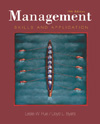 |  Management: Skills and Application, 10/e Leslie W Rue,
Georgia State University - Emeritus
Lloyd L Byars,
Georgia Institute of Technology
Developing Employees and Managers
Chapter Summary| 1. Define human asset accounting. Human asset accounting involves determining and recording the value of an organization's human resources in its statement of financial condition.
2. Describe the orientation process. Orientation is the introduction of new employees to the organization, their work units, and their jobs.
3. Define training. Training is a process that involves acquiring skills or learning concepts to increase the performance of employees.
4. Define needs assessment. Needs assessment is a systematic analysis of the specific training activities required to achieve the organization's objectives.
5. Discuss vestibule training, apprenticeship training, and computer-based training. In vestibule training, procedures and equipment similar to those used in the actual job are set up in a special working area called a vestibule, where the trainee learns the job at a comfortable pace without the pressures of production schedules. Apprenticeship training generally lasts from two to five years and requires the trainee to work under the guidance of a skilled worker over this period. Computer-based training allows the trainee to absorb information from a preset computer program in a self-paced format.
6. List and define the most popular methods of management development. Understudy assignments require the person who will someday have a specific job to work for the incumbent to learn the job. With coaching, experienced managers advise and guide trainees in solving management problems. Job rotation exposes a manager to broad experiences in many different areas of the organization. Role playing requires trainees to act out assigned roles in a realistic situation. In-basket techniques require the trainee to answer one manager's mail and telephone calls. Business games generally provide settings of the company and its environment and require a team of players to make operating decisions.
7. Describe an assessment center. An assessment center utilizes a formal procedure to simulate the problems a person might face in a real managerial situation to evaluate the person's potential as a manager and determine the person's development needs.
8. List the steps involved in the evaluation of training and management development. The four steps in the evaluation of training and management development are (1) reaction (how well did the trainees like the program?), (2) learning (what principles, facts, and concepts were learned in the program?), (3) behavior (did the job behavior of the trainees change because of the program?), and (4) results (what were the results of the program in terms of factors such as reduced costs or reduced turnover?). |
|



 2003 McGraw-Hill Higher Education
2003 McGraw-Hill Higher Education